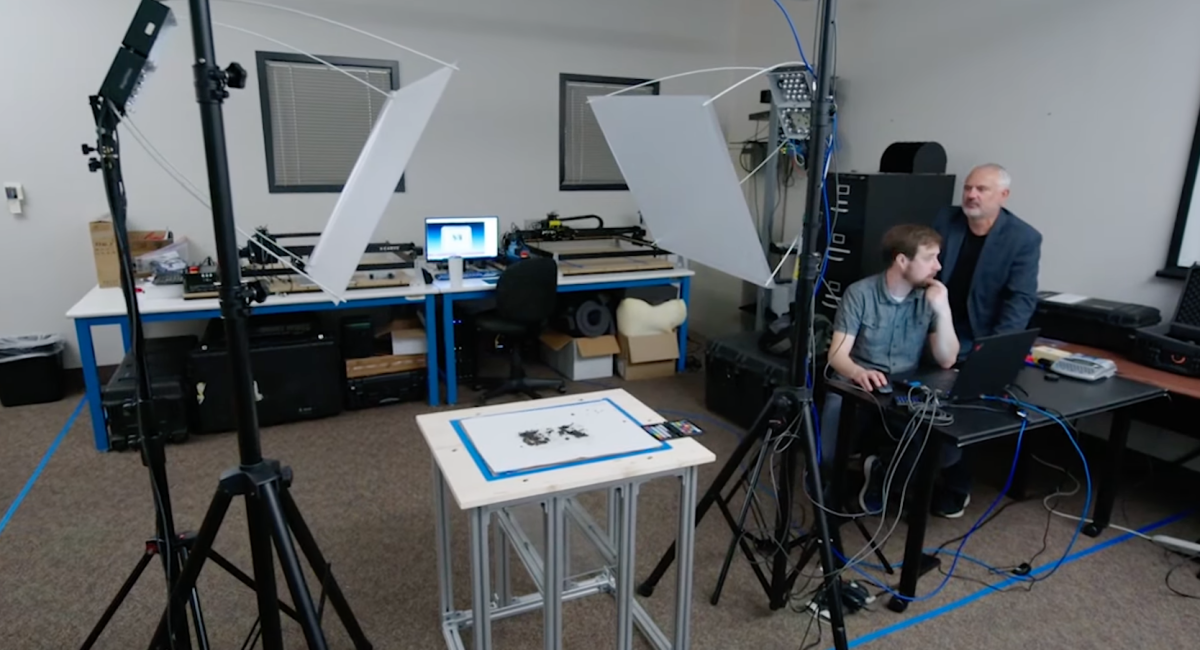It may seem like nonsense to believe in the power of time machines, but people like Brent Seales, a computer science professor at the University of Kentucky, have proven the opposite, Seales said.
After more than a decade of working with ancient manuscripts, Seales and his team managed to read the first word from the 2,000-year-old completely carbonized and closed Herculaneum scrolls, using new artificial intelligence mechanisms.
The AI is what bridges the gap between what exists within the scrolls and what is visible to the human eye, and “we can turn the knobs on that AI and we can make certain things pop out that aren’t obvious,” Seales said. Which, in the researchers’ case, was the ink of the scrolls.
“The scrolls were actually like a time machine … I started working in the late nineties with antiquities, meaning, you know, old manuscripts, old things, paintings, and it wasn’t until we had some success doing that that I started thinking about scrolls,” Seales said.
The great impact of this discovery, Seales said, is that these Herculaneum scrolls come from the only extensive library of the Classical Period — which once was believed to be the mansion of Julius Caesar’s father-in-law — that contained around 2,000 books in the format of scrolls.
The process of reading these ancient scrolls, Seales said, was carried out by “virtual unwrapping.” In simpler terms, virtual unwrapping involves turning a closed material into an open book.
“The data that we get when we make a digital copy of something that is completely closed up is just a volume, it’s unstructured, it’s like a map of the inside without having any labels on anything. So if you imagine doing that for a book, you know that there are pages in there but you don’t really know who the pages are; you look at the data and then you can sort of see that they are there,” Seales said.
Part of the challenge in investigating those scrolls through the concept of virtual unwrapping is that they are not as manageable to read as a book with visible pages.
“What virtual unwrapping is, is define where the pages are, model them, and then pull them out so they (lay) flat. With a book, that’s easy because all the pages are already flat in their volume but with a scroll is harder because the surface that the writing is on is actually unwrapped up,” Seales said.
The Herculaneum scrolls’ structure and carbonized materials brought a separate challenge for Seales and his team, said Stephen Parsons, a research advisor for the Vesuvius Challenge — a competition platform that offers incentives for scientists to make more discoveries about the Herculaneum scrolls.
“The Herculaneum scrolls are extra challenging and they’ve resisted being read in this way for so long because as objects they make things difficult in almost every way possible. With Herculaneum scrolls, the ink is made out of soot, which is pure carbon, and the scrolls are made out of papyrus, which is a plant which is almost pure carbon so in a X-ray image they look the same, it’s like the same shade of gray,” Parsons said.

To overcome those ancient barriers, the team had to create and train, through AI, tools that could tell them what their eyes could not see.
“So even if you do all the work to trace the page and virtually flatten it, it looks like a blank sheet. And what we’ve developed over the years is machine learning tools that show that we actually can recover the ink from those scans, it’s just a really, really subtle pattern that doesn’t appear to our naked eye, so we have to train a model to do it for us,” Parsons said.
In order to develop such a technology, it was imperative to use AI in an innovative way, which, Seales said, arrived later during his team’s breakthrough.
“The AI helps us enhance things that are in the data but are really hard to see with the naked eye, and there is a lot in there,” Seales said.
Each step of this research required new devices and advanced AI so that all levels of damage could be overcome.
For Seales and his team, he said, it was necessary to find a way to make the ink, which is not made of metal, more noticeable in the scans. It was also necessary to find a way to restore the papyrus from being completely charred to a more manageable material as well as find a political and ethical way to have access to these scrolls through establishing external collaborations.
But such an effort to overcome barriers left Seales and his team considering a famous phrase: if you fail to understand history, you are doomed to repeat it.
Seales said that, through the Herculaneum scrolls, he and his team found a unique opportunity to have complete access to the past in order to understand the present and the future.
“I think there is another important principle in play too and that is sometimes it’s hard to have conversations about things that are difficult and the past can lead us to those conversations,” Seales said. “If we go back far enough, all of the politics, all the dissension, all the things that divided us sort of dropped away and they melt away into the mist of history and then we find something like a scroll where we have common ground and we can talk about things.”
This breakthrough interested UK researchers and computer scientists, like Parsons, in studying more advanced topics and solving different issues after the successful discovery of the Herculaneum scrolls.
“There’s a lot of work I find really exciting with the Herculaneum scrolls,” Parsons said. “In particular, I think most of that work will become applicable to other collections as well and probably other applications outside of cultural heritage so this may have medical applications and so on.”
Being able to read Herculaneum scrolls was already a great step forward but they are still looking for advanced mechanisms to “read the entire collection in a fast way,” Parsons said.
Sydney Chapman, a senior majoring in computer science with a minor in mathematics, was one of the undergraduate researchers who worked alongside Seales. She was responsible, together with her laboratory partner, for developing different devices, such as a quick segment tool, to facilitate the virtual reading of the scrolls.
Chapman said that even after all the progress in this study on the scrolls, her curiosity for more details regarding the scrolls’ material hasn’t ceased.
“We haven’t been able to get back a conclusive ‘This is what we’ve agreed on what this says.’ We know who the authors probably are from previous research, but I’m interested in what it actually contains; even though we haven’t been able to unwrap an entire scroll, even parts and pieces are nice to understand,” Chapman said.
Seales also highlighted what may come next.
He and his team are going to enhance what they already discovered. As they perfect their methods, they will programmatically understand how the technological tools that they used can be useful for other areas.
“The damage that was done is the very thing that saved it. So there’s an irony that’s deeply embedded right in this material. The carbonization and the bearing of what happened is that thing that actually makes it possible for us to have it now,” Seales said.




























































































































































Ronald Braun • Dec 28, 2023 at 3:50 pm
Very nice work. Keep the public apprised of your continuing work please. Thank you and your team.
Peter Jaimex • Dec 27, 2023 at 1:45 pm
Congratulations. What is the content of the scroll? Something epicurean?. Cheers